Acedia
Acedia (/əˈsiːdiə/; also accidie or accedie /ˈæksɪdi/, from Latin acēdia, and this from Greek ἀκηδία, “negligence”, ἀ- “lack of” -κηδία “care”) has been variously defined as a state of listlessness or torpor, of not caring or not being concerned with one’s position or condition in the world.
In ancient Greece akidía literally meant an inert state without pain or care.
SLOTH (Laziness, Indolente, Desidia, Accidia, Pigritia, La Paresse, Trágheit,
The original drawing, in the Albertina, Vienna, is dated 1557.
Many a modern must find this not only the most passive and negative but in many ways the most haunting and shattering of Bruegel’s seven Sins.
It symbolizes the evils of the vice which was treated with more irony and folksy fantasy in “The Land of Cockaigne,” reproduced as Plate 32. In that print, Plenty has destroyed ambition, energy, activity.
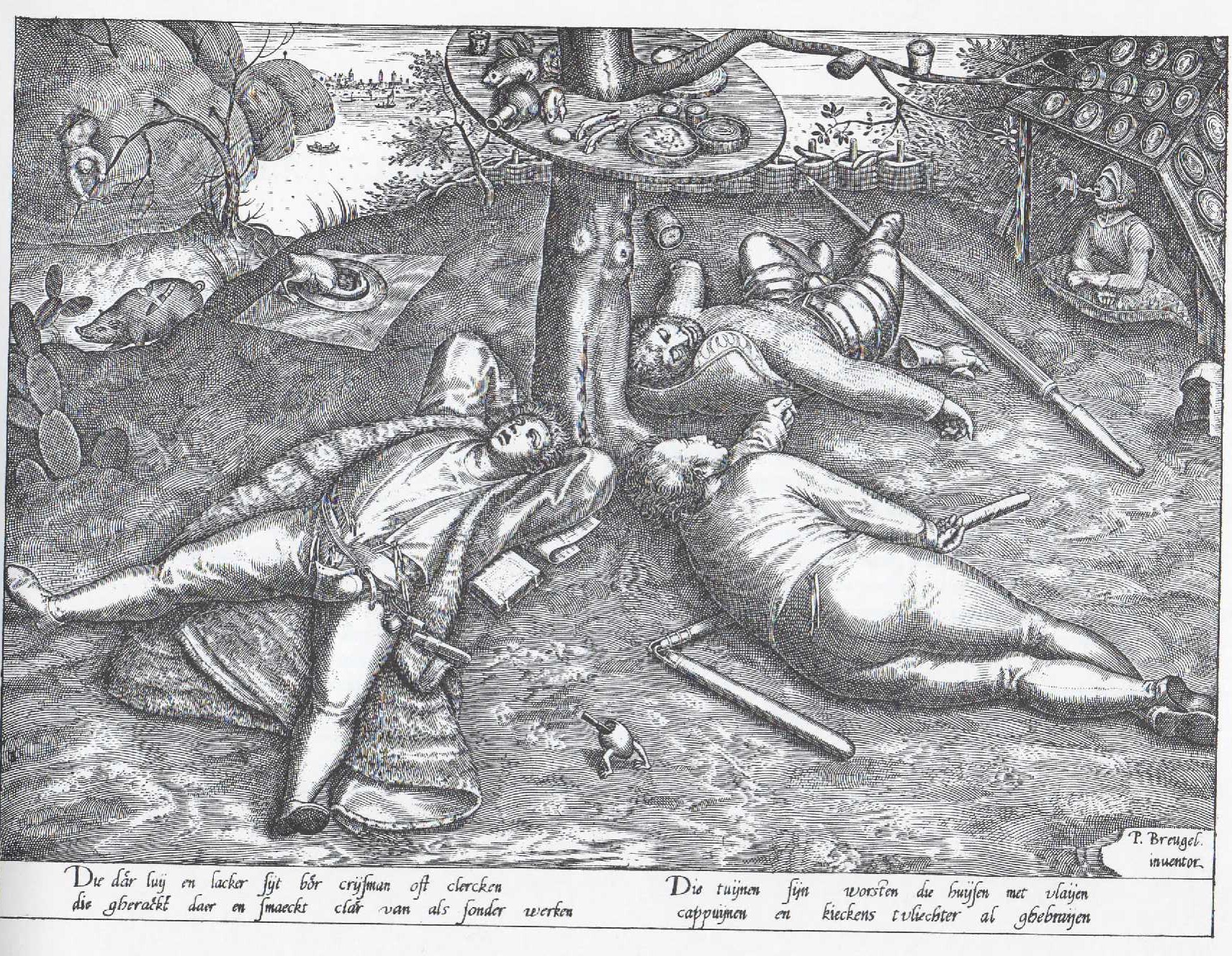
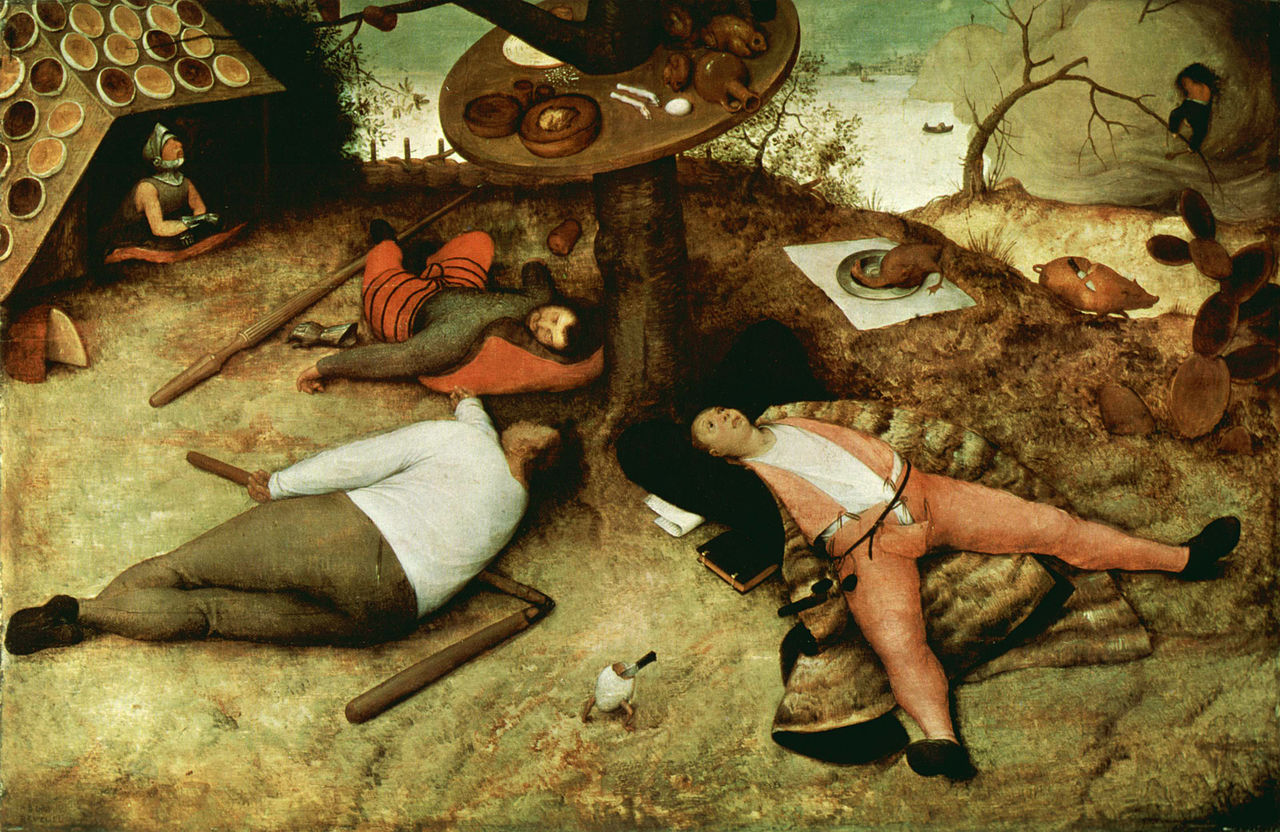
The arrangement of the clerk, peasant, and soldier underneath the tree suggests the men as the spokes of a wheel, where the tree is the hub. The roasted fowl lies in the place where a fourth spoke could be.
Ross Frank has argued that the painting is a political satire directed at the participants in the first stages of the Dutch Revolt (1568–1648), where the roasted fowl represents the humiliation and failure of the nobleman (who would otherwise form the fourth spoke of the wheel) in his leadership of the Netherlands, and the overall scene depicts the complacency of the Netherlandish people, too content with their abundance to take the risks that would bring about significant religious and political change.[3]
The painting has also been cited as illustrating the Freudian oral stage of psychosexual development,[4] showing a paradise of oral pleasure. It is used to demonstrate how human beings achieve oral pleasure and stimulation from eating and simply having things in the mouth.
see here more info: The land of Cocagne
Here, Sloth herself, older and uglier than the other allegories, sleeps open-mouthed in a landscape of delay, decay, and ultimate impotence
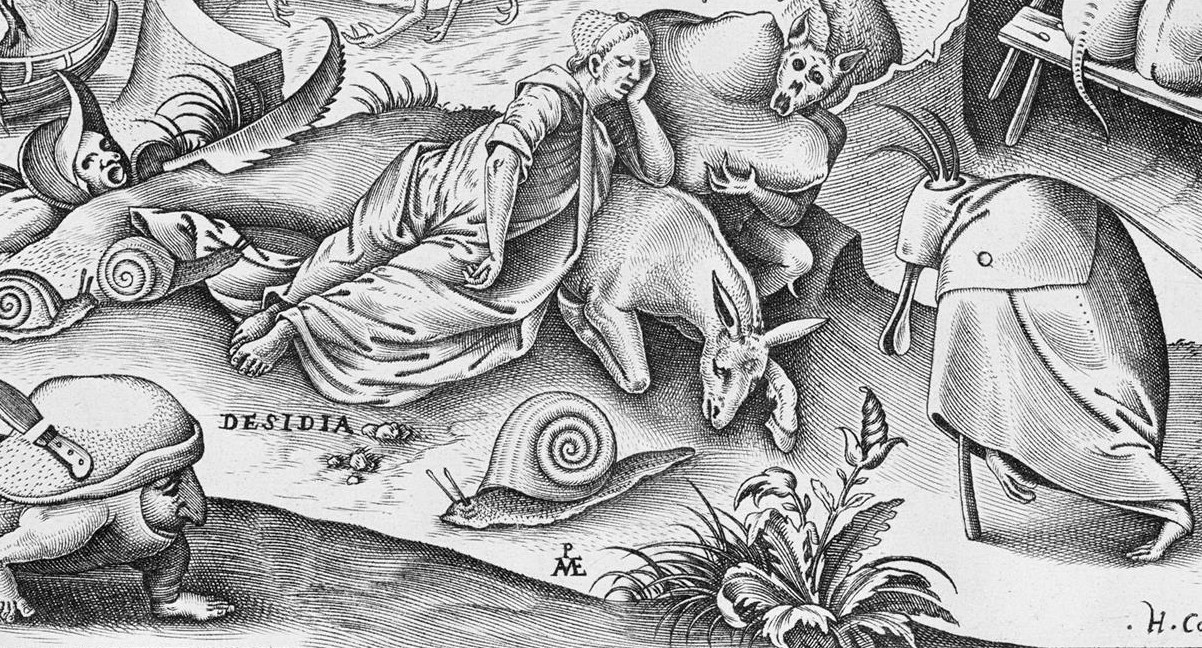
She reposes on her beastly counterpart, a sleeping ass. A monster behind her adjusts her pillow. Around her crawl huge snails. Even the hill of Sloth is soft as shown by a winged demon sawing into it at left. One art historian sees the saw as a suggestion of Dame Sloth’s snoring as she sleeps. Another regards the sawman as a symbol for malicious gossip, his mouth ever open as he cuts away the ground from under others. ( To try to let the other come in problems).
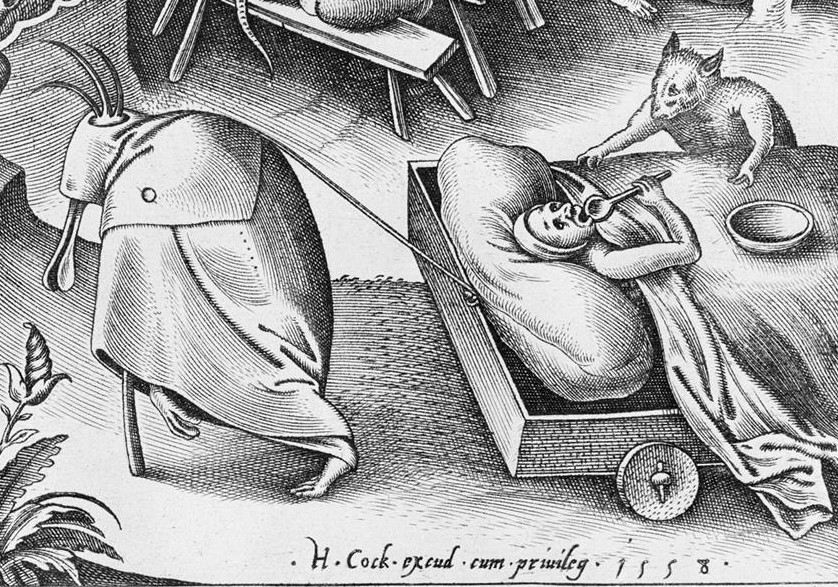
From the right, a stork-beaked monster in monk’s garb drags a sinner too indolent to leave his bed; he eats as he lies. The counterpart of this monk, Tolnay finds in Bosch’s ” Temptation of St. Anthony” painting (Lisbon). At the lower left, on a nearer hillock, trawls an all-head-and-feet monster, dragging a tail half fish, half branch. A hollow tree, farther left, contains a great pig’s head and provides a perch for a demon bird.
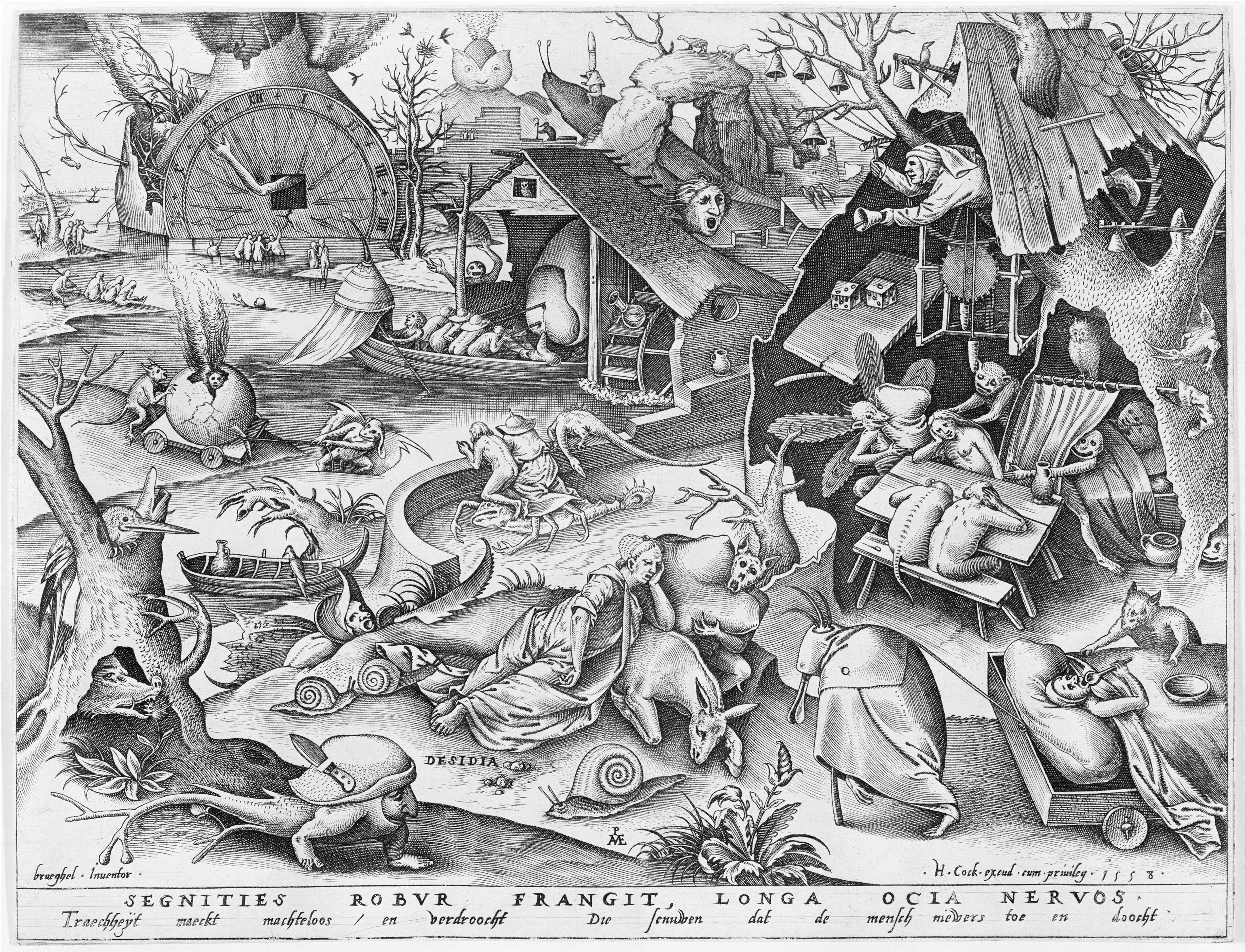
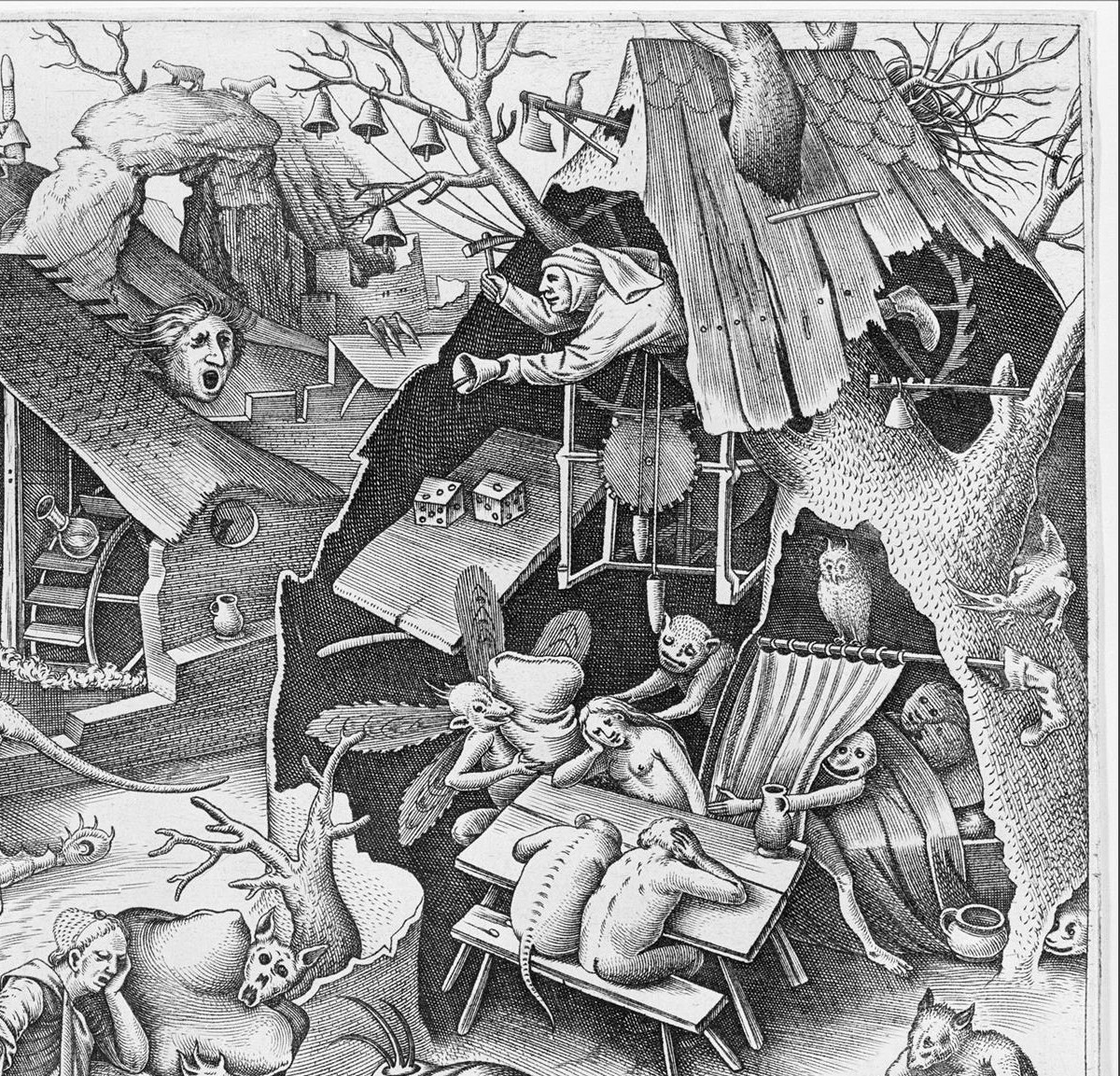
The hollow-tree symbol is extended enormously to the right of Dame Sloth. In this shell-like structure mingling building and tree, naked sinners and monsters sleep around a table. A couple lie together in bed behind a curtain. The demon leers around it as he seeks to draw the sleeping girl inside. Sloth or excess leisure encourages lechery. An owl, again, looks down cryptically.
Dice on the table to the left of the owl refer perhaps to gambling by lazy time-wasters. A man, caught in a great clockwork above, strikes a bell with a hammer. Tolnay reads this as a kind of pun, for in the Flemish lui ( Luid)signified both the verb “to ring” (as a bell), and the adjective “lazy.”
The idea of clock and time a-wasting appears again at the upper left. Like some effect in a Jean Cocteau motion picture, a human arm points to 11 o’clock. The lazy leave things till the eleventh hour.
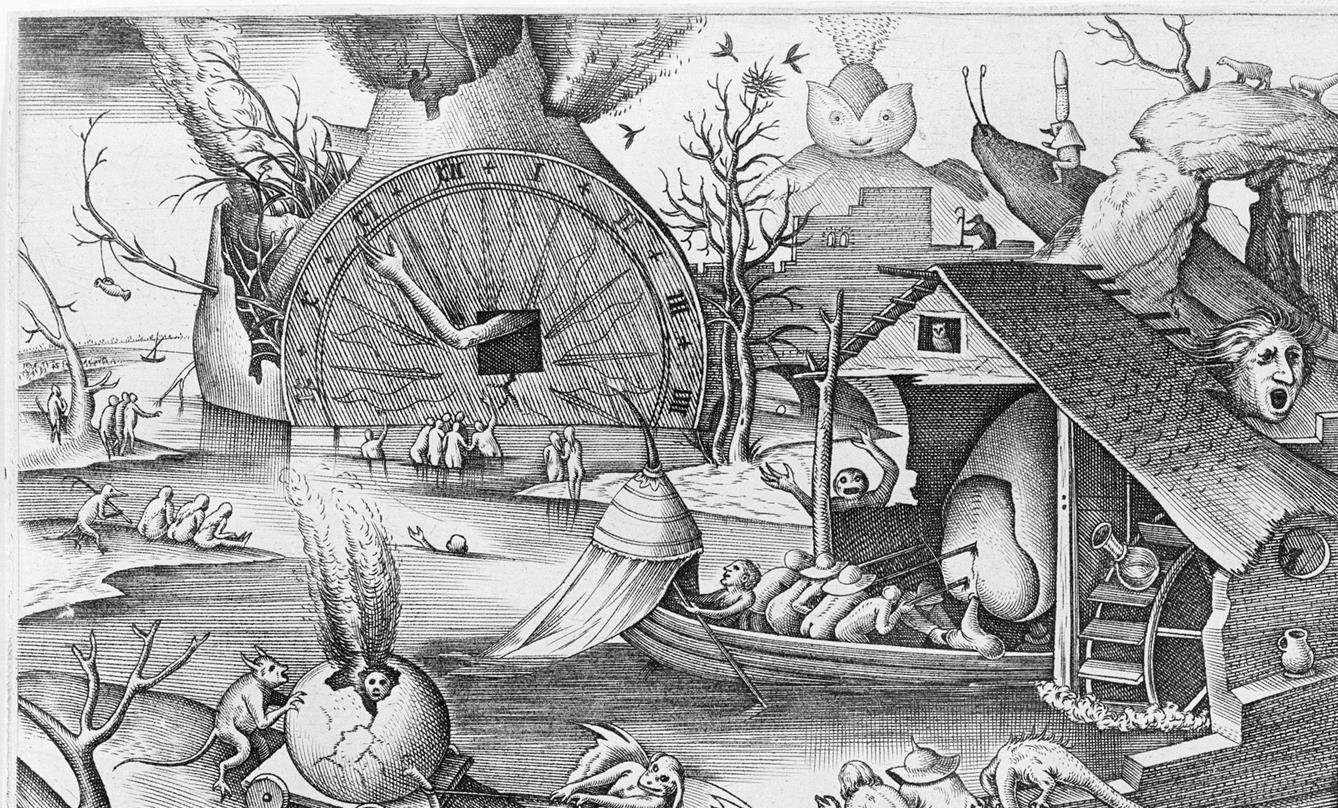
And catastrophe lies behind—a blaze is burning up the broken structure, filled with dead branches.
A little to the right, just below the top margin, a mountain top with human face spouts smoke. A little farther to the right an enormous slug raises its feelers into the sky as it trawls through a stone arch. On its neck rides an almost unreadable strange distortion: a monster with a shaft (candle ?) instead of a head.
Below, just above center, a squatting giant, built into a mill, enacts a proverb common to many a culture: “He’s too lazy to shit.” The faceless midgets in the boat behind him are inducing a bowel movement with poles and pressure. Another owl looks through a small square window in the roof above this operation.
On the bank, somewhat to the left, two demons drag into the water of sin a woman almost bidden inside a seething hollow egg, which looks also like a beet or turnip.
References to many other Flemish proverbs have been shown or suspected. Basic to the complicated spectacle as a whole is the thought in the Flemish rhyme below the print. It is roughly rendered in English thus : Translation of Latin caption: Sloth breaks strength, long idleness ruin the sinews
The various examples of lazy or slothful behavior, in evidence in the surrounding landscape, colorfully demonstrate the message of the inscription below: “Sloth makes man powerless and dries out the nerves until man is good for nothing.”
In short, sloth, far from resting, recuperating and rejuvenating,waste a man away, renders him impotent and good for nothing.
He becomes like a slug, a slave of the stupefied tyrant machine, DAME Desidia or Acedia , ἀκηδία, “negligence”, ἀ- “lack of” -κηδία “care”) has been variously defined as a state of listlessness or torpor, of not caring or not being concerned with one’s position or condition in the world.
Mentally, acedia has a number of distinctive components of which the most important is affectlessness, a lack of any feeling about self or other, a mind-state that gives rise to boredom, rancor, apathy, and a passive inert or sluggish mentation. Physically, acedia is fundamentally associated with a cessation of motion and an indifference to work; it finds expression in laziness, idleness, and indolence.
Emotionally and cognitively, the evil of acedia finds expression in a lack of any feeling for the world, for the people in it, or for the self. Acedia takes form as an alienation of the sentient self first from the world and then from itself. Although the most profound versions of this condition are found in a withdrawal from all forms of participation in or care for others or oneself.
Sloth not only subverts the livelihood of the body, taking no care for its day-to-day provisions, but also slows down the mind, halting its attention to matters of great importance.
Sloth hinders the man in his righteous undertakings and thus becomes a terrible source of human’s undoing
In his Purgatorio Dante portrayed the penance for acedia as running continuously at top speed. Dante describes acedia as the “failure to love God with all one’s heart, all one’s mind and all one’s soul”; to him it was the “middle sin”, the only one characterised by an absence or insufficiency of love, virtue and uprightness.
The antidote Industria meaning Craftmanship , Diligence ,Persistence, effortfulness, ethics, Virtues and sincere uprightness.
- The Tower of Babel by Breughel
The Tower of Babel was the subject of three paintings by Pieter Bruegel the Elder. The first, a miniature painted on ivory, was painted while Bruegel was in Rome and is now lost.[1][2] The two surviving paintings, often distinguished by the prefix “Great” and “Little”, are in the Kunsthistorisches Museum, Vienna and the Museum Boijmans Van Beuningen in Rotterdam respectively. Both are oil paintings on wood panels.
with thanks to;https://maypoleofwisdom.com/acedia-lack-of-care-disease-of-our-times/
[I have covered 'Babel Tower' in My 'One Idiot' Post re;'Phenols']
Originally in Christianity there were 8 'Deadly Sins' Not 7 [as They became known]
'The Eight Capital Sins' by Evagrius included ACEDIA ...which was later combined with 'SLOTH'
Evagrius dubbed acedia the “demon of noontide,” a reference to Psalm 91. Siegfried Wenzel, in his book The Sin of Sloth: Acedia in Medieval Thought and Literature, wrote that “in the end acedia causes the monk to either give in to physical sleep, which proves unrefreshing or actually dangerous because it opens the door to many other temptations, or to leave his cell and eventually the religious life altogether.”
Modern interpretations of acedia liken it to depression or ennui, though some religious groups view acedia and depression as separate maladies.
https://www.atlasobscura.com/articles/desert-fathers-sins-acedia-sloth
Noonday demon
Etymologically, acedia joins the negative prefix a- to the Greek noun kēdos, which means "care, concern, or grief."
It sounds like apathy, but Cassian's description shows that acedia is much more daunting and complex than that.
Cassian and other early Christians called acedia "the noonday demon," and sometimes described it as a "train of thought."
sound familiar? Nietzsche wrote about 'The Great Noontide' etc
but 'High Noon' Dude? wasn't Lloyd Bridges and Gary 'Cooper' involved?
Mono-Poly ....[I have covered previously in this blog re; the Artist 'Teniers'.. 'Mono' being Spanish for 'Ape' [Monkey]
'Poly' being many etc 'Polly' being an old Christian Monk's name for 'Satan'
So in effect even the 7 'Deadly Sins' which in Combination are facets of negativity are false
because the 'Eight Trains of Thought' or '8' were the True Original 'Sins'
'Polyamorous' means having a relationship with two or more People at the same time.



.jpg)
Comments
Post a Comment